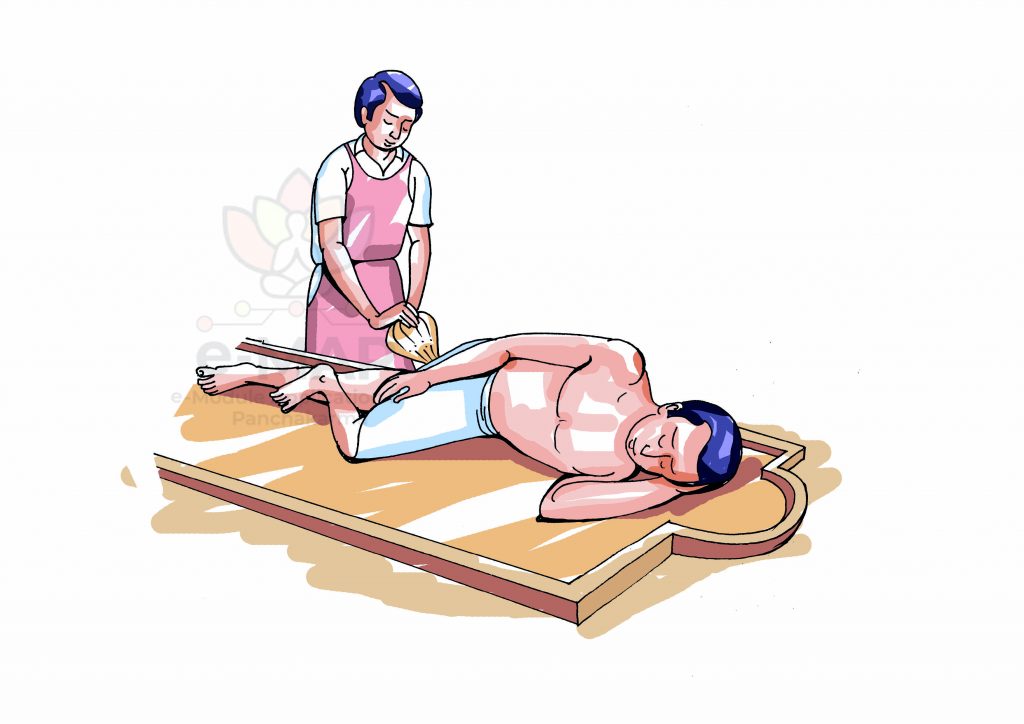
PG Module 6
BASTI KARMA

EXPLANATORY NOTES
Basti Karma is classified into three steps
1)Pūrvakarma
2) Pradhāna Karma
3) Paścāt Karma
Pūrvakarma includes –
SambhāraSaṅgraha
ĀturaParīkṣa
Basti Kalpana
ĀturaSiddhata.
SambhāraSaṅgraha
It is the collection of materials which are required
- Basti Netra
- Basti Puṭaka
- If it is done in can method, then enema apparatus (can), rubber catheter
- Oil for Abhyaṅga.
- Oil for lubrication of the Basti Netra and Guda.
- Cotton piece.
- Medicines for treating Ayoga and Atiyoga of Basti.
- A pair of disposable gloves.
- Materials required for the preparation of Basti Dravya in required quantities.
- Thread for tying.
- RāsnadiCūrṇa – 5 g. for application to the vertex of the head after bath.
ĀturaParīkṣa
समीक्ष्य [१] दोषौषधदेशकालसात्म्याग्निसत्त्वादिवयोबलानि|
बस्तिः प्रयुक्तो नियतं गुणाय स्यात् सर्वकर्माणि च सिद्धिमन्ति||६|| (Cha.Si.3/6)
Basti has to administered after considering the Doṣā, Auṣadha, Deśa, Kāla, Sātmya, Agni, Satva, Vaya, and Bala. By considering these only the effective results can be attained.
Basti Kalpana
It is the preparation of Basti Dravya, which has been explained in detail previously.
ĀturaSiddhata
पक्षाद्विरेको वान्तस्य ततश्चापि निरूहणम् | (Su.Chi.36/51)
After Vamana and VirecanādiŚodhana Karma, Nirūha Basti should be administered after a fortnight.
अथानुवासितमास्थापयेत्;| स्वभ्यक्तस्विन्नशरीरमुत्सृष्टबहिर्वेगमवाते शुचौ वेश्मनि | (Su.Chi.38/3)
Āsthāpana Basti / Nirūha Basti should be administered to the person who has been given Anuvāsana Basti earlier. The patient should be given oleation and sudations first, asked to void excrements, stay in house devoid of breeze and is clean.
रूक्षस्य बहुवातस्य द्वौ त्रीनप्यनुवासनान् |
दत्त्वा स्निग्धतनुं ज्ञात्वा ततः पश्चान्निरूहयेत् ||४४|| (Su.Chi.37/44)
It has been told that if the person is more Rūkṣa, then 2 or 3 AnuvāsanaBasti can be given initially. Similarly, if the person is having more Snigdhataand Mala Sañcaya, then NirūhaBasti can be administered directly after the administration of Abhyaṅga and Svedana.
तैलाक्तगात्रं कृतमूत्रविट्कं नातिक्षुधार्तं शयने मनुष्यम्| (Cha.Si.3/16)
Patient who has eliminated vit, Mūtra and Vāta and not having too much hunger should be given SarvāṅgaAbhyaṅga and Svedana as a prerequisite for Nirūha Basti.
Time of administration
अथानुवासितमास्थापयेत्; स्वभ्यक्तस्विन्नशरीरमुत्सृष्टबहिर्वेगमवाते शुचौ वेश्मनि मध्याह्ने प्रततायां|| (Su.Chi.38/3)
Basti has to be administered in the Madhyāhna (afternoon), after the digestion of the previous meal and when the person is not having too much hunger.
Positioning of the patient
समेऽथवेषन्नतशीर्षके वा नात्युच्छ्रिते स्वास्तरणोपपन्ने||१७||
सव्येन पार्श्वेन सुखं शयानं कृत्वर्जुदेहं स्वभुजोपधानम्|
सङ्कोच्य सव्येतरदस्य सक्थि वामं प्रसार्य प्रणयेत्ततस्तम्||१८|| (Cha. Si.3/17-18)
Patient should be made to lie down over a well spread, and not very high pillow which is uniform in level or which is slightly low in level at the head side. The patient should lie comfortably on his left lateral position and he should use his folded left hand as pillow. He should then flex his right knee, keeping the left leg fully extended.
वामाश्रये हि ग्रहणीगुदे च तत् पार्श्वसंस्थस्य सुखोपलब्धिः||२४||
लीयन्त एवं वलयश्च तस्मात् सव्यं शयानोऽर्हति बस्तिदानम्|२५| (Cha.Si.3/24-25)
As the Grahaṇī and Guda are located in the left side of the body, while administration when the patient is lying on his left side will have efficient results. In this position the sphincters remain submerged into the surrounding musculature. This position allows the flow of Dravya by gravity into the sigmoid colon and rectum. Therefore, the Basti Dravya enters the rectum very smoothly and reaches till the Grahaṇī easily and produces the desired effect.
Insertion of Basti Netra
स्निग्धे गुदे नेत्रचतुर्थभागं स्निग्धं शनैरृज्वन पृष्ठवंशम्|
अकम्पनावेपनलाघवादीन् पाण्योर्गुणांश्चापि विदर्शयंस्तम् ||१९ (cha.si.3/19)
After lubricating the Guda, the lubricated nozzle should be inserted into it up to 1/4th part from the top slowly and straight following the position of the vertebral column. The physician should not shake or tremble his hand and he should easily compress the bladder so that the Dravya goes inside at one stretch. Thereafter, he should take out the nozzle slowly.
Basti PīḍanaKāla
प्रपीड्य चैकग्रहणेन दत्तं नेत्रं शनैरेव ततोऽपकर्षेत्|२०| (Cha.Si.3/20)
With the single compression on the Puṭaka, inject the Dravya and slowly, and gradually withdraw the Netra from the Guda.
बस्तिं सव्ये करे कृत्वा दक्षिणेनावपीडयेत् |
एकेनैवावपीडेन न द्रुतं न विलम्बितम् ||४||
ततो नेत्रमपनीय त्रिंशन्मात्राः पीडनकालादुपेक्ष्योत्तिष्ठेत्यातुरं ब्रूयात् | (su.chi.38/4)
The Basti Puṭaka has to be squeezed with the right hand and the Puṭaka should be held with the left hand. It should be squeezed neither too fast, nor too slow and it should be completed in one pressing. After Basti Pīdana, the patient is instructed to take rest for 30 MātraKāla and then get up and sit in Utkutukāsana.
विड्वातवेगो यदि चार्धदत्ते निष्कृष्य मुक्ते प्रणयेदशेषम् ||२५| (Cha.Si.3/25)
In the middle of the administration, if the patient gets the urge to pass the Vegas, then the Netra has to be removed and ask the patient to void the Vegas. Thereafter the remaining Basti Dravya can be administered again.
Positioning of the patient after administration
उत्तानदेहश्च कृतोपधानः स्याद्वीर्यमाप्नोति तथाऽस्य देहम् |२६| (cha.si.3/26)
After the administration of Basti, the patient is made to lie on his/her back comfortably, by keeping a pillow in such a way that the body is raised. So that the Vīryaof the Basti spreads throughout the body.
उत्तानोदत्तमात्रेतुनिरूहेतन्मनाभवेत्॥४६॥
कृतोपधानःसञ्जातवेगश्चोत्कटकःसृजेत्। (A.Hr.Su.19/44)
After the administration of the Basti, the patient is made to lie on his / her back with an Upadhāna (pillow). When the patient gets the Vega, he / she should eliminate it by sitting in hip flexed position (squatting position).
आगतौपरमःकालोमुहूर्तोमृत्यवेपरम्॥४७॥
तत्रानुलोमिकंस्नेह–क्षार–मूत्राम्ल–कल्पितम्।
त्वरितंस्निग्ध–तीक्ष्णोष्णंवस्तिम्अन्यंप्रपीडयेत्॥४८॥
विदद्यात्फल-वर्तिंवास्वेदनोत्त्रासनादि च ।
स्वयम्एवनिवृत्तेतुद्वितीयोवस्तिर्इष्यते ॥ ४९ ॥
तृतीयोऽपिचतुर्थोऽपियावद्वासु-निरूढ-ता । (A.Hr.Su.19/47-49)
The maximum time taken for the expulsion of Nirūha Basti is one Muhūrta, after which it can lead to other complications or Mṛtyu. In case of any delay in its expulsion, give another Nirūha Basti prepared with Sneha, Kṣāra, Mūtra and Amla Dravyas having Snigdha, Tīkṣṇa, Uṣṇa properties is administered immediately. Phalavarti, Svedana, or Trasana can also be administered. If the Nirūha Basti gets eliminated on its own, then second, third, or fourth Basti can be administered subsequently till SamyakLakṣaṇas of Nirūha Basti is observed.
अनायान्तं मुहूर्तात्तु निरूहं शोधनैर्हरेत् ||१७||
तीक्ष्णैर्निरूहैर्मतिमान् क्षारमूत्राम्लसंयुतैः |१८|
विगुणानिलविष्टब्धं चिरं तिष्ठन्निरूहणम् ||१८||
शूलारतिज्वरानाहान्मरणं वा प्रवर्तयेत् |१९| (Su.Chi.38/17-19)
ĀcāryaSuśruta also mentions one Muhūrtaas the PratyāgamanaKālaof Basti. If it does not get expel complications can occur like Śūla, Arati, Jvara, Ānāha, and even Maraṇacan happen.
SAMYAK YOGA LAKṢAṆAS
प्रसृष्टविण्मूत्रसमीरणत्वं रुच्यग्निवृद्ध्याशयलाघवानि||४१||
रोगोपशान्तिः प्रकृतिस्थता च बलं च तत् स्यात् सुनिरूढलिङ्गम्|४२|(Cha.Si.1/41-42)
Evacuation of the bowel, urine and flatus without any discomforts, ruchi for ahara, agnivṛddhi, āśayalaghavata, rogaupaśamana, restoration of normal health and balavardhana are samyakLakṣaṇas of Nirūhabasti.
विरिक्त–वच्चयोगादीन्विद्याद् (A.Hr.Su.19/50)
ĀcāryaVāgbhaṭa enumerates that the Samyak, Ayoga and AtiyogaLakṣaṇas of Nirūha Basti are similar to that of Virecana.
यस्य क्रमेण गच्छन्ति विट्पित्तकफवायवः ||१०||
लाघवं चोपजायेत सुनिरूढं तमादिशेत् |११|(Su.Chi.38/10-11)
The person in which the faeces, Pitta, Kapha and Vayu (flatus) come out in that order and the feeling of lightness of the body appears, then he is to be considered as properly treated by Nirūha Basti.
AYOGA LAKṢAṆAS
स्याद्रुक्छिरोहृद्गुदबस्तिलिङ्गे [१] शोफः प्रतिश्यायविकर्तिके च||४२||
हृल्लासिका मारुतमूत्रसङ्गः श्वासो न सम्यक् च निरूहिते [२] स्युः|४३| (Cha.Si.1/42)
Lakṣaṇas such as Ruk in the Śira, Hṛdaya, Guda, Basti, Śopha in LiṅgaPradeśa, Pratiśyāya, Parikartika, Hṛllāsa, MārutaSaṅga, MūtraSaṅga, and Śvāsa are NirūhaAyogaLakṣaṇas.
यस्य स्याद्बस्तिरल्पोऽल्पवेगो [१] हीनमलानिलः ||८||
दुर्निरूढः स विज्ञेयो मूत्रार्त्यरुचिजाड्यवान् |९| (Su.Chi.38/8-9)
If the Basti is expelled in less quantity, with less force and expels deficient quantity of faeces and Vāta causing dysuria, Aruci and Jādyata.
ATIYOGA LAKṢAṆAS
लिङ्गं यदेवातिविरेचितस्य भवेत्तदेवातिनिरूहितस्य||४३|| (Cha.Si.1/43)
कफास्रपित्तक्षयजानिलोत्थाः सुप्त्यङ्गमर्दक्लमवेपनाद्याः||१९||
निद्राबलाभावतमःप्रवेशाः सोन्मादहिक्काश्च विरेचितेऽति|२०| (Cha.Si.1/19-20)
The AtiyogaLakṣaṇas of Nirūha Basti is same as that of the AtiyogaLakṣaṇas of Virecana.
They are: due to the excessive administration of Virecana Karma, it gives rise to ailments caused by the aggravation of Vāta, as a result of the diminution of Kapha, Rakta and Pitta, Supti, Aṅgamarda, Klama, Vepanadi, Anidra, Abala, TamaPravesha, Unmāda and HikkaLakṣaṇas are observed.
भोज्यं पुनर्व्याधिमवेक्ष्य तद्वत् [१] प्रकल्पयेद्यूषपयोरसाद्यैः||३४||
सर्वेषु विद्याद्विधिमेतमाद्यं वक्ष्यामि बस्तीनत उत्तरीयान्|३५| (Cha.Si.3/34-35)
The diet of the patient is determined on the basis of the nature of one’s disease. It should consist of Yūṣa, Payas, Māṃsarasa etc. when the meal is digested, on the same day evening, after taking light diet, Anuvāsana Basti is administered to provide Bala.
विद्याद्योगेतुयोजयेत्कोष्णेनवारिणास्नातंतनुधन्वरसौदनम्
विकारायेनिरूढस्यभवन्तिप्रचलैर्मलैः||५१||
तेसुखोष्णाम्बुसिक्तस्ययान्तिभुक्तवतःशमम्| (A.Hr.Su.19/51)
The complication of NirūhaBasti caused by Pracalamalas(dislodged faeces and vitiated Doṣas will subside by UṣṇaJala Snāna, followed by food. As PathyaĀhāra; TanuMāṃsaRasa, Odana, Dhanva Rasa etc. can be administered.
सुनिरूढं ततो जन्तुं स्नातवन्तं तु भोजयेत् [१] ||११||
पित्तश्लेष्मानिलाविष्टं क्षीरयूषरसैः क्रमात् |
सर्वं वा जाङ्गलरसैर्भोजयेदविकारिभिः ||१२|| (Su.Chi.38/11-12)
After the elimination of the Basti, the patient should be bathed and advised to take food. The diet should be Kṣīra, Yūṣa, Māṃsarasa for the diseases of Pitta, Kapha and Vāta respectively or in general JāṅgalaMāṃsarasa is the food sufficient after Nirūha Basti even including Svastha.



